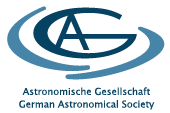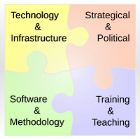

Annual Meeting 2020 of the Astronomische Gesellschaft, Virtual MeetingS, Germany
Both are addressing the transformation of astrophysics into a digital science, and help to unfold the full potential of instrument and satellite data.
This Virtual Meeting shows the application of Machine Learning to all areas of astronomy, and also, that more solid built digital infrastructures for the precious data are needed.
In the last decade, the field of artificial intelligence (AI) and machine learning (ML) has vastly expanded, and several ML methods have recently been used in astronomy. Their big advantage is that they give computers the ability to learn from data without being explicitly programmed. Whereas for classical numerical methods we need to know all (complex) 'rules' beforehand, an ML algorithm can detect patterns automatically. In astronomy, the number of studies that apply ML techniques has risen substantially in the last years. Unsupervised learning algorithms have been used to identify different kinematic components of simulated galaxies, to compare stellar spectra, to classify pulsars, and to find high-redshift quasars. Supervised learning has been used to classify variable stars, to find exoplanets, to link galaxies and dark matter haloes, to classify galaxies morphologically, and to determine the redshift of galaxies. New developments include the application of modern learning approaches, such as semi-supervised, reinforcement, or representation learning, and state-of-the-art ML methods, such as generative adversarial networks, recurrent networks, or encoder-decoder-architectures. The ML sessions are inspired by the growing adoption of ML approaches in the astronomy community. We aim to bring together researchers applying ML techniques to data intensive problems in the fields of exoplanets, stars, the interstellar medium, galaxies, and cosmology. This includes approximating physical processes, analysing large data sets, understanding what a learned model really represents, and connecting tools and insights from astrophysics to the study of ML models. The goal is to discuss and share new approaches, disseminate recent results, understand the limitations, and promote the application of existing algorithms to new problems. We expect to strengthen the interdisciplinary dialogue, introduce exciting new possibilities to the broader community, and stimulate the production of new approaches to solving challenging open problems in astronomy.
Tuesday, 22.09.2020, 09:00 - 13:00 , Virtual Room G
Wednesday, 23.09.2020, 09:00 - 13:00 , Virtual Room G
H. Enke (AIP), K. Polsterer (HITS), Benjamin Moster (LMU)
Tuesday,22.09.2020
|
PUNCH4NFDI and ESCAPE
| |
| H.Enke | Welcome + Intro |
| M. Allen | ESCAPE |
| M. Steinmetz | PUNCH4NFDI |
| Discussion | |
| Break | |
|
| |
| A. D'ISanto | MEGAVIS - Real-time spectra analysis and visualization with autoencoders |
| F. Kollasch | UltraPink - A web based frontend for rotation and flipping invariant Kohonen Maps |
| C. Koepferl | Using realistic synthetic observations to improve observational techniques |
| A. Malik | Exoplanet Detection using Machine Learning |
| E. Hopkins | Finding a Needle in a Haystack: the search for gravitational lenses |
Wednesday, 23.09.2020
If you have any further questions, please don't hesitate to contact us
Harry Enke: henke [at] aip [dot] de
Kai Polsterer: kai.polsterer [at] h-its [dot] org
Benjamin Moster: moster [at] usm [dot] lmu [dot] de